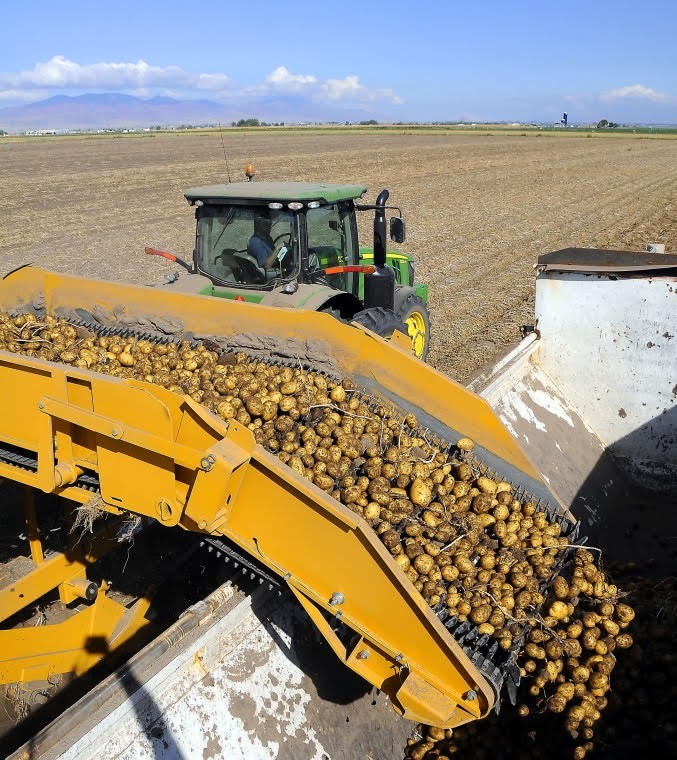
Courtesy & Copyright Eli Lucero, Photo Editor
The Herald Journal, Logan Utah
 Potatoes
Potatoes
Courtesy U.S. Department of Agriculture (USDA)When I walked into the Potato Museum in Blackfoot, Idaho, the first thing that caught my eye was a drawing of a farmer in the High Andes of Peru working the ground with a foot harrow. This is exactly what the Spanish Conquistadors saw when they marched into the area in the 1500’s looking for gold.
What they found instead was the potato. The Spaniards took the potato back to Europe, from where it eventually made its way to North America in the 1600’s. As for Utah, Brigham Young bought the potato here. Richard Jensen, writing for Utah’s LDS historical Society, tells us: “About noon, on July 24, the five acre potato patch was plowed when the brethren commenced planting their seed potatoes. The first irrigation in Salt Lake Valley was for the benefit of the newly planted potatoes.”
What Brigham Young didn’t know was that a small wild cousin of the domesticated potato was already here. In 2017 an anthropologist, Lizbeth Lauderback, was able to dig out the tiny bits of organic matter wedged into the stone grinding tools used by the Native Americans near Escalante. The organic bits proved to be potato starches. The stone tools were 10,000 years old.
But now the domesticated potato took over the field. The hefty Idaho Russet caught the eye of the McDonald food chain. They produced a fascinating video for the museum from inside their factory where the peeled potatoes were dropped in a fast moving water slide, accelerating to 50, 60 miles per hour. And BAM, they hit the slicer and came out the other side as slender, shapely strips now well on their way to becoming fries.
Back in Cache Valley, I was lucky enough to get invited to the Beutler Farm in Dayton to watch the potato harvest. Out in the field a giant harvester was forging ahead, scooping potatoes off the ground, bouncing them onto conveyor belts, and then sending them tumbling out a side chute into the bed of a potato truck keeping step alongside. Just as the truck filled to capacity, another truck sidled up behind and matched its pace with the giant machine.
The whole scene reminded me of the more formal dances in my high school, where couples would glide around the dance floor until another boy would sidle up behind the dancing boy, tap him on the shoulder, and take his place.
Keeping the rhythm of the dance of the potato trucks was the somewhat urgent beat of a ticking clock–potatoes still in the fields after a freeze would be ruined.
Falling in behind a departing truck, I was led to the above ground storage cellar where the potatoes were being piled into a massive wall that towered over my head. The wall was 22 foot high., and the potatoes kept coming. When the cellar was finally full, the doors were closed, the temperature and humidity controls set, and 8 million pounds of seed potatoes were left to wait out the winter at a cool 38 degrees.
The trucks moved on to filling the next cellar.
I was left standing there, marveling at just how many potatoes there were, wanting to sing the praises of all growing things, especially this farm’s successful mix of seed and sweat, of soil, of sun, of rain.
This is Mary Heers and I’m Wild About Utah.
Credits:
Photos:
Featured Audio: Courtesy & Copyright © Friend Weller, Utah Public Radio upr.org
Text: Mary Heers, https://cca.usu.edu/files/awards/art-and-mary-heers-citation.pdf
Additional Reading: Lyle Bingham, https://bridgerlandaudubon.org/
Additional Reading
Wild About Utah, Mary Heers’ Wild About Utah Postings
Idaho Potato Museum, https://idahopotatomuseum.com/
First use of wild potato in N. America Four Corners potato previously unknown part of ancient human diet, University of Utah, July 3, 2017, https://www.ars.usda.gov/ARSUserFiles/274/Bamberg%20Press/Four_Corners.pdf and Morning Ag Clips, https://www.morningagclips.com/first-use-of-a-wild-potato-in-n-america/
Eating a potato with 11,000 years of cultural history, Includes photos by BJ Nicholls, Imagine, The University of Utah, Spring 2021, https://magazine.utah.edu/issues/spring-2020/ancient-spuds/
Davis, James W. and Stillwell, Nikki Batch, Aristocrat in Burlap, A History of the Potato in Idaho, Idaho Potato Commission, December 1992, https://idahopotato.com/aristocrat-in-burlap/online/8
Harwell, William S. and Collier, Fred C., Manuscript History of Brigham Young 1847–1850, Collier’s Publishing Co., Jan 1, 1997https://books.google.com/books?id=u33Szoj3pFQC&pg=PA61&lpg=PA61#v=onepage&q&f=false
and https://www.amazon.com/Manuscript-History-Brigham-Young-1847-1850/dp/0934964041/
O’Connell, John, Idaho potato industry sees good signs for profitable fall crop, Intermountain Farm & Ranch, Post Register (Idaho Falls, ID), Jul 29, 2019, https://www.postregister.com/farmandranch/crops/potatoes/idaho-potato-industry-sees-good-signs-for-profitable-fall-crop/article_e9d4a968-96df-5bf5-9e53-ba6df41c5947.html
Flandro, Carly, From the classroom to the spud cellar: harvest break teaches life lessons, EastIdahoNews.com, September 22, 2022, https://www.eastidahonews.com/2022/09/from-the-classroom-to-the-spud-cellar-harvest-break-teaches-life-lessons/
